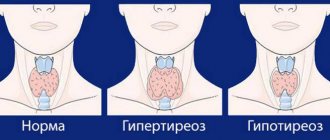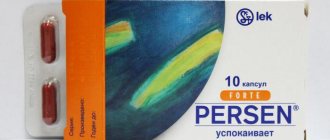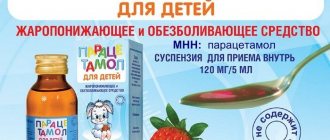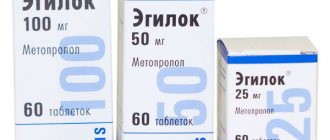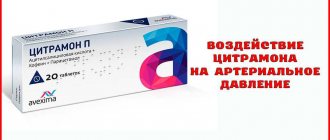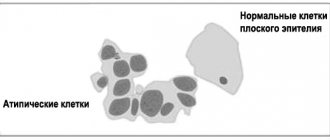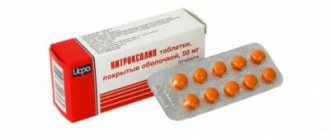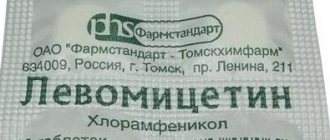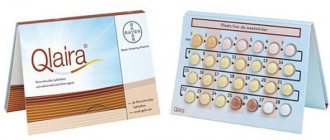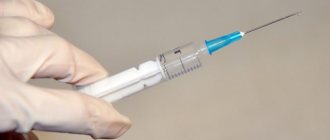Medicinal drugs, absolutely legal, are sold in every pharmacy, arousing great interest among teenagers. The fact that they are sold over the counter creates misconceptions about certain medications. Trigan D, Pentalgin N, Baklosan - it’s worth taking these medications out of your home medicine cabinet and hiding them more reliably if teenagers live in the apartment. The pills have caused a terrible epidemic of drug addiction among schoolchildren, which no one talks about out loud.
Compound
Trigan-D is available in tablet form and consists of several components: paracetamol and dicycloverine.
Paracetamol
Non-narcotic analgesic, antipyretic (lowers body temperature). Has an analgesic and antipyretic effect.
Paracetamol blocks enzymes that catalyze prostanoid biosynthesis or cyclooxygenase in the central nervous system. In this case, the effect occurs on the center of pain and thermoregulation. Due to this, blood vessels dilate and peripheral blood flow improves. In its pure form, paracetamol is not an anti-inflammatory drug.
Dicycloverine
An antispasmodic or muscle relaxant is a drug that reduces spasm and muscle tone. At the same time, motor activity decreases. In large doses it leads to immobilization.
It is used in medical practice to reduce hyperactivity of the gastrointestinal tract in irritable bowel syndrome, when constant spasm occurs.
In patients with glaucoma it leads to increased intraocular pressure. May increase heart rate. If the dose is incorrectly selected, it leads to suppression of the endocrine glands, which is manifested by dryness of the oral mucosa and respiratory tract. Dilates the bronchi. Dicycloverine is harmless if not abused.
The combination of these two components of Trigana-D provides the body with persistent relaxation of spasming muscles and relieves pain.
pharmachologic effect
The key function of this drug is the ability to suppress pain and relieve fever caused by the inflammatory process. The main load lies on paracetamol, which acts as an inhibitor of cyclooxygenase processes in the central nervous system and peripheral tissues, resulting in:
- areas responsible for the severity of pain sensations are blocked;
- inflammation is reduced;
- thermoregulation is influenced.
Dicycloverine hydrochloride has a similar effect, but it works with the smooth muscle tissue of internal organs, also providing an antispasmodic effect. In tandem, the active ingredients of the tablets help to cope with pain of any etiology and reduce body temperature (however, Trigan-D should not be used as a cold remedy). The drug can relieve pain in half an hour to an hour - the time it takes for the formation of the maximum level of active substances in the blood.
https://www.youtube.com/watch?v=upload
Regarding the metabolization of paracetamol occurring in the liver, it is necessary to clarify that:
- Most of the breakdown products are excreted through the kidneys, about 20% - with feces.
- One of the metabolites of paracetamol can be dangerous for the liver and kidneys.
Many people try to find information about the drug Trigan D on Wikipedia. The necessary information is not available in this system. Instructions for use and reviews from doctors answer the question: “What is Trigan D?” Belongs to the group of antispasmodic analgesics. The medicine has analgesic, thermoregulatory, antispasmodic and minor anti-inflammatory properties.
The effect of the medication is due to the inclusion of paracetamol and dicycloverine hydrochloride in its composition. The first substance counteracts the reproduction of prostaglandins, mediators responsible for pain reactions, inflammatory and temperature processes in the body.
Dicycloverine hydrochloride, which is part of the Trigan D tablets, from which they help relax smooth muscles, creates a myotropic antispasmodic effect. The medicine does not cause atropine-like side effects.
The combined action of the active substances allows you to get rid of pain symptoms and relax the smooth muscles of the internal organs. The maximum effect of the drug is observed one hour after administration.
Medical use
The spectrum of action of Trigan-D is quite wide. It helps to cope with many pains.
- Colic. They come in different origins – hepatic, renal.
- Spasmodic contractions of internal organs. For example, vasospasm.
- Irritable bowel syndrome, when there is a painful contraction of the smooth muscles of the intestine.
- Gynecological diseases. These include: dysmenorrhea (cramping pain in the uterus during menstruation), algodismenorrhea - pain in the uterus with increased nervous excitability.
- Myalgia or muscle soreness.
- Acute respiratory infections, acute respiratory viral infections and other infectious diseases that are manifested by an increase in temperature.
- Before painful diagnostic procedures or in the postoperative period.
- In rheumatological practice to relieve joint pain.
- For radiculitis and other neurological pain.
Important! All of the above points are only help for short-term symptom relief, but not treatment.
The drug disrupts the functioning of the endocrine glands, so it is prescribed very carefully at elevated ambient temperatures. Trigan-D reduces sweating, so overheating and heat stroke may occur. The drug is prescribed very carefully to asthmatics, as they are prone to bronchospasm.
About the drug
Trigan D is a combined action analgesic and antispasmodic analgesic. Eliminates pain due to spasms of smooth muscle organs.
The main active substance – dicycloverine – eliminates intestinal, renal, biliary colic, relieves menstrual pain, and is taken for spastic constipation, irritable bowel syndrome, and pylorospasm. Excipient – paracetamol (has a mild antipyretic effect). Their interaction improves the analgesic effect and accelerates the onset of the drug's effect.
Available in the form of tablets in paper packages of 10, 20, 100 units. Manufactured in India, owned by Cadila Pharmaceuticals.
The active substance dicycloverine has a high absorption rate into the blood within a short period of time. The maximum concentration is reached 2 hours after administration. The drug is excreted from the body up to 80% along with urine.
Trigan D can be used in both adults and children over 12 years of age. The maximum permissible single dose is 2 tablets, daily dose is 4 tablets. Treatment can last no more than five days.
Trigan-D as a drug
As mentioned above, this medicine is an antipyretic and analgesic. But any medication has side effects, especially when it is abused. Namely:
- dry mouth;
- dizziness;
- disturbance of visual perception;
- tachycardia (fast heartbeat);
- anemia;
- excitation;
- decreased appetite;
- vomit.
In this case, dicycloverine plays a leading role in the occurrence of side effects. This is the very “interesting” narcotic component of Trigan-D, which in normal dosages does not have a harmful effect on the body.
Analogs
There is no complete replacement for the drug Trigan-D in terms of composition (most of the analogues are single-component), but according to medical catalogs you can find tablets with a similar effect and a budget price. Doctors call the following drugs the most effective:
- No-Shpa;
- Drotaverine;
- Spasmol;
- Cystenal;
- Dicetel;
- Papaverine;
- Bendazole.
Analogs have a similar effect to the drug "Trigan D":
- "Trimspa."
- "Duspatalin."
- "Moreaze SR".
- "Mebsin Retard."
Effect
Young people and teenagers, and this is usually the category that cannot afford anything more expensive, have learned to use Trigan-D to relax or have fun.
A dangerous dose of this drug is approximately 10 tablets (it all depends on personal tolerance). This amount causes hallucinations and short-term memory loss.
But young people have learned to adapt to contraindications, inventing new ways of self-satisfaction:
- light – a couple of tablets with a low-alcohol drink;
- regular – 5 pieces of Trigana-D, washed down with beer;
- strong/deadly when taking 10 or more tablets of the drug, mixing it with alcoholic drinks, but not every body can withstand such a load.
- in order to “preserve” their health, Trigan-D is cleared of paracetamol (which has a very destructive effect on the liver) and then the resulting solution is consumed.
The duration of the effect of such relaxation is usually 5-6 hours. It all depends on the volume of use of Trigan-D as a drug.
Trigan D: effects of overdose and consequences of poisoning
https://www.youtube.com/watch?v=ytadvertiseen-GB
The main effect of the drug and its analogues is analgesic. When the therapeutic dose is exceeded, mild euphoria is observed; in severe cases, hallucinations are observed, which outwardly look like schizophrenic delusions. Drug addicts call the effect caused by Trigan D a “trip” - by analogy with synthetic hallucinogenic drugs.
Dicyclomine is maximally concentrated in plasma one to one and a half hours after taking the tablets, and paracetamol after 30 minutes. The peak effect is observed 2 hours after receiving the drug. Drug addicts who take Trigan “see” realistic pictures, not always positive and colorful. People addicted to the drug talk to non-existent interlocutors, they begin to become paranoid and panic.
Trigan is a drug that is common among teenagers and schoolchildren (there it is called “trigande”, “triganda” or “trigana”). It is easy to get, it is inexpensive, and is sold in almost all pharmacies. Dicycloverine (the drug has an effect primarily due to its presence) is isolated from tablets in home or “clandestine” conditions to enhance its effect.
In many ways, the composition of the drug and its availability became the decisive factors for its widespread use not as a medicine, but as a drug, especially among schoolchildren.
The narcotic effect of an overdose of Trigan D (among teenagers it is called “trigande” or “trigande”) is euphoria in case of a slight overdose and hallucinations with a large dosage, which are greatly enhanced by drinking alcohol.
Significantly exceeding the recommended dosage instructions has a strong effect on the brain - the range of consequences of taking Trigan D includes mental illness, liver dysfunction, coma and death.
Trigan D contains two widely used medicinal substances:
- Dicycloverine hydrochloride belongs to the group of antispasmodics that block muscarinic receptors. Due to its anticholinergic activity, it has a relaxing effect on smooth muscles, therefore it relieves intestinal, renal and biliary colic well, relieves pain during menstruation, and is prescribed for spastic constipation, irritable bowel syndrome and pyloric spasm.
- Paracetamol is a non-narcotic antispasmodic with a mild antipyretic effect. Ignoring contraindications when taking it leads to irreversible toxic damage to the liver, kidneys and endocrine glands.
The combination of dicycloverine and paracetamol makes it possible to enhance the effect of the first component of the substance several times.
For most people, if the recommended dosage is increased, an effect appears similar to that of a narcotic, which quickly becomes psychologically addictive. From the point of view of physical effects on the body, Trigan D is even worse than soft drugs like marijuana.
The instructions indicate that Trigan D is intended for the relief of pain syndromes in persons over 12 years of age, and the dosage regimen must comply with the following standards:
- one-time – no more than 2 tablets;
- daily – no more than 4 tablets;
- the time interval between doses is at least 4-6 hours.
Unintentional overdose of the drug is possible in the following cases:
- The expectation is almost instant pain relief. The instructions say that the painkiller effect of the drug occurs 1-1.5 hours after administration. Without waiting for a quick effect, a person takes the Nth number of additional tablets.
- Many people take Trigan D as a regular analgesic - upon the resumption of pain, ignoring the warning about the minimum permissible time interval between doses.
- In both cases, the majority decides to double the dose, which leads to a one-time and daily overdose.
- It remains unclear why a drug that has such a dangerous effect from taking only 4 tablets instead of the prescribed 2 was put on free over-the-counter sale.
When using Trigan D as a drug, other “nuances” are possible.
If in the case of a one-time use of 5-8 tablets we can still talk about severe poisoning, then the consequences of 9-10 or more tablets are, at best, a reversible coma.
There is evidence on the Internet that teenagers, in pursuit of euphoric intoxication, swallow 20 tablets at a time, but this is an almost guaranteed fatal outcome.
To enhance the effect, tablets are washed down with energy drinks or alcohol, combined with barbiturates and other psychotropic substances, which is even more destructive and dangerous for the body.
If we do not take into account the most dangerous consequence of such “compounds” – death, Trigan D and alcohol pose the greatest harm to the body.
https://www.youtube.com/watch?v=ytpolicyandsafetyen-GB
The fact is that the paracetamol content in these tablets is 500 mg (which corresponds to the maximum single dosage for adults), and to achieve a “high” you need to drink at least 4 tablets.
Taking small amounts of alcohol at the same time leads to toxic irreversible damage to liver cells and end-stage renal failure.
Acute poisoning with Trigan D is possible if it is taken simultaneously with certain antibiotics and antiviral drugs, for example, Zidovudine or Rifampicin.
Symptoms of poisoning
In case of poisoning with the drug Trigan D, the following clinical picture is characteristic:
- dry mouth;
- chills and fever;
- unclear perception of objects, “protruding glass” gaze;
- attacks of nausea, loss of appetite, vomiting;
- severe dizziness and loss of coordination of movements;
- arrhythmia and decreased heart rate are replaced by tachycardia;
- wandering pain in the abdomen, but mainly in the epigastric region;
- visual and auditory hallucinations;
- first excitement and euphoria, then drowsiness;
- convulsions, muscle weakness, possible paresis or paralysis of the limbs;
- urinary retention;
- frequent, uneven breathing;
- inappropriate behavior;
- partial memory loss.
In severe cases of overdose, papillary and renal necrosis develop, leading to coma and death.
If signs of overdose are detected, you should immediately call an ambulance.
This is due to the fact that it will be difficult to provide first aid to a person in case of poisoning with signs of drug addiction (for example, rinsing the stomach) - the victim either behaves inappropriately or is unconscious. In the latter case, the person should be placed on his side so that he does not choke on vomit until the medical team arrives.
Treatment of an overdose with Trigan D occurs only in a hospital setting and includes:
- Gastric lavage (in difficult cases using a tube);
- Taking adsorbents - activated carbon, Polysorb, Enterosgel, etc.;
- Intravenous administration of acetylcysteine to increase the formation of glutathione;
- Taking methionine to enhance the conjugation reaction;
- If necessary, a psychiatrist is involved.
Consequences
Using this drug in doses that do not comply with the instructions will sooner or later lead to serious consequences. Any violation of the regulations is manifested by intoxication or poisoning of the body, and poison, as is known, tends to accumulate in the body.
Symptoms of abuse of this drug:
- decreased or loss of vision;
- muscle atrophy and destruction;
- violation of movement coordination;
- liver destruction;
- kidney failure;
- hypoglycemic coma (sharp decrease in blood sugar levels).
Trigan-D with alcohol
While using this drug, you should not drink alcohol-containing drinks - one of the negative features of paracetamol is a conflict with alcohol, resulting in toxic damage to liver cells. If the patient already has pathologies of this organ, the danger increases. Combining dicyclomine with alcohol is also not recommended, since this increases the degree of negative impact on the nervous system, provokes memory loss, hearing and vision disorders.
Drug addiction
Two, at first glance, useful drugs - paracetamol and dicycloverine - complement each other in Trigan-D. And this is a trap for many teenagers and young adults called “addiction.” The action of the drug is similar to narcotics and very quickly causes psychological and physical attachment. According to doctors and pharmacists, the effect of Trigan-D is similar to that of hard drugs.
In the modern world, parents, as a rule, are busy with financial issues, and children and teenagers are left alone with the street. There, “friends” will always be able to listen and understand them, who will then offer the drug Trigan-D. It is highly addictive, so it is worth devoting more time to preventing drug addiction.
Many parents do not even suspect that their home medicine cabinets contain painkillers, which modern youth have “learned to swallow” instead of drugs. When you come to the pharmacy and, without a second thought, ask the pharmacist to give you something for muscle pain or headaches, you may be offered the cheap Indian drug Trigan D with the accompanying phrase - Try it, it helps everyone. Helping helps, but not only...
The pills have caused a terrible epidemic of drug addiction among schoolchildren, which no one talks about out loud. Its popularity is due to its availability and low price, a little more than 100 rubles per pack of 20 tablets.
Reference: Trigan-D is an antipyretic, analgesic, antispasmodic drug. The active ingredients of the drug are Dicycloverine and Paracetamol. Available in the form of white, round, flat, smooth tablets with beveled edges and a score on one side.
In pharmacies you can find an analogue of this drug - combispasm. This medicine has a similar composition and effect.
The combination of dicycloverine and paracetamol allows you to enhance the effect of the first active ingredient several times. But this same combination, as it turned out, in most people, if the prescribed dosage is increased, causes an effect similar to a narcotic, which, by the way, quite quickly causes mental addiction. And from the point of view of the physical effect on the body, Trigan D is even worse than soft drugs.
Visions in teenagers most often manifest themselves in the fact that they are catching some objects or collecting them, hiding or being afraid of something. In this state, the heart rate increases to 160 beats per minute. An increased amount of atropine is found in their urine.
People who abuse anticholinergic drugs eventually become patients in drug dispensaries and are forced to undergo treatment for acute poisoning. Therefore, you should avoid getting Trigan-D into the hands of adolescents; the instructions for use contain precise information about the therapeutic dosage, which should be followed for treatment. Proper use of these tablets guarantees their safety.
It remains unclear why a drug that has such a dangerous effect from taking only 4 tablets instead of the prescribed 2, successfully passed clinical trials and went on sale over the counter.
Trigan D and alcohol pose the greatest harm to the body. Why? The fact is that the paracetamol content in these tablets is 500 mg, which corresponds to the maximum single dosage for adults, and to achieve a pseudo-high you need to drink at least 4 tablets. Taking even a small amount of alcohol (0.3 beers) and extremely high doses, and in this case an overdose of paracetamol, leads to toxic irreversible damage to liver cells and end-stage renal failure.
If the drug is not used medicinally, side effects may occur:
First aid for drug poisoning
If a person takes too many Trigan-D tablets, he may overdose. It may have the following symptoms:
- Pale skin.
- Cramps.
- Fever.
- Anemia.
- Dilated pupils.
- Vomiting.
- Paranoia.
- Drowsiness.
If it has been established that a person has used Trigan-D and he exhibits one of the above symptoms, he must be provided with first aid. Namely:
- Place a person.
- Perform gastric lavage.
- If it is impossible to perform gastric lavage, induce vomiting.
- Give a person to consume activated carbon at the rate of 1 tablet per 1 kilogram of weight.
Additionally, it is necessary to call doctors or take the person to a hospital, where he will receive more professional assistance and undergo a detoxification procedure.
Many parents do not realize that the painkillers in their children's medicine cabinets can be used as an alternative to drugs to obtain unusual sensations. The main danger of such products as Trigan-D is that they are sold by every pharmacy in any quantity and without a prescription. Due to this, the consuming teenager and his parents have a high probability of encountering an overdose of the drug and subsequent negative consequences.
Overdose of Trigan-D
An overdose of the drug may cause liver failure. With excessive use of Trigan-D, the following effects are observed: nausea, vomiting, jaundice, bitterness in the mouth, loss of appetite, irritability, lethargy, pain in the hypochondrium on the right side, abnormal stool consistency. An overdose of Trigan-D can lead to severe disturbances in the functioning of the entire body and to death .
According to online reviews, some young people, in pursuit of euphoric intoxication, swallow 10 to 20 tablets at a time, and consuming this amount is already fatal. If in the case of a one-time use of 5-8 tablets we can still talk about severe poisoning, then the consequences of 9-10 or more tablets are, at best, a reversible coma.
"Trigan-D" is strictly contraindicated and can lead to serious consequences, these include: - acute or chronic renal failure; - impaired liver function, insufficiency of this organ; - allergy to medication components; - the patient has acute or chronic gastritis (inflammation of the gastric mucosa), peptic ulcer; - gastrointestinal bleeding; — period of pregnancy and lactation; - nonspecific ulcerative colitis; - cardiovascular failure; - children under 15 years of age; - increased intraocular pressure, glaucoma; - myasthenia gravis; - prostatitis, prostate adenoma.
Overdose of pills
If you take 5 Trigan D tablets, severe intoxication will already occur. Teenagers eat 9-11 tablets in pursuit of a high. It is not surprising that a pathological condition occurred in every second user of Trigan D. Overdose symptoms are similar to poisoning with any other drugs. Depression of body systems, nausea, weakness, changes in blood pressure and pulse. Some people just feel slightly unwell—a little nauseous and find it harder to breathe. Another may lose consciousness and fall into a coma. To prevent this from happening, you should know how to provide first aid.
- Call an ambulance and briefly explain the cause of the poisoning. If doctors know why a person was poisoned, this will make their work easier. Do not be afraid that others will find out about the fact of using pills. It’s much worse to do nothing, which will lead to the death of a person.
- After the ambulance has already left, you need to induce vomiting in the poisoned person. Getting yourself to drink a few glasses of water can be a challenge, but it's something that needs to be done. Then two fingers under the root of the tongue, and the body begins to cleanse itself.
- Give a stomach cleanser. If the action takes place in an apartment, the home medicine cabinet almost always contains activated carbon. Take one tablet per 10 kg of person's weight.
- Until the ambulance arrives, continue to drink drinking water, but not in glasses, but in sips every couple of minutes. This will speed up the excretion of the substance by the kidneys.
It may happen that a person loses consciousness. In this case, you need to place it on a flat surface. There is a possibility that the poisoned person may suffocate either due to vomiting or due to the curling of the tongue and blocking the main respiratory channel. To prevent this from happening, you need to turn his head to the side, keep his pulse and breathing under control.
A medical team arrived at the scene and hospitalized the victim. On the spot, he will be given medications to normalize the functioning of the cardiovascular system. Depending on the severity of the condition, the poisoned person may end up in the intensive care unit or toxicology department.
First aid and treatment for overdose.
If signs of overdose are detected, you should call an ambulance. This must be done because it will be difficult to provide first aid in case of poisoning with signs of drug addiction, for example, to rinse the stomach. The poisoned person will behave inappropriately or be unconscious. In the latter case, before the specialists arrive, the person should be placed on his side so that he does not choke on the vomit.
As antidotes, intravenous administration of methionine is used - after 8 hours, and after 12 hours - N-acetylcysteine. Treatment of an overdose with Trigan D occurs only in a hospital setting. If necessary, a psychiatrist is involved.
Trigan-D is a simple medicine found in your home medicine cabinet. It is used to relieve pain of various etiologies. However, this drug is often used by young people as a drug substitute. As a rule, when asking a pharmacist for an inexpensive medicine for pain in the muscles or head, patients are offered a drug from India. It shows results and more.
special instructions
Paracetamol, which is part of the drug, can change laboratory test results. If you need to use Trigan-D in combination with metoclopramide, domperidone or cholestyramine, you should consult a specialist.
Paracetamol distorts the results of laboratory tests when detecting the amount of glucose and uric acid in plasma.
Paracetamol is not recommended to be taken together with alcohol, or for people who abuse alcohol, as this may result in toxic liver damage.
The likelihood of liver disorders is increased in patients suffering from alcoholic hepatosis.
With a long course of taking Trigan-D tablets, you need to monitor peripheral blood counts and liver functionality.
Impact on the ability to drive vehicles and other mechanisms
During the period of therapy, it is necessary to refrain from driving a car, as well as other activities that require high alertness and rapid psychomotor reactions.
Use in pediatrics
The drug should not be used by children under 15 years of age.
In case of malfunction of the kidneys and liver
Patients with kidney or liver dysfunction should take Trigan-D with extreme caution.:
- anticoagulants;
- other drugs against pain and inflammation;
- medications that affect the central nervous system.
Video: “Overview and description of the drug Trigan-D”
Composition of Trigan-D
The instructions for use do not contain any hint that the indicated drug causes narcotic effects. In addition, the medication is available without a prescription and for special purposes. This results in the medicine being freely available to both adults and children. But we hear warnings from narcologists about exceeding the permissible limits for taking Trigan-D. When an increased dose enters the body, a state of euphoria occurs, hallucinations, and death are possible.
Both components of the drug separately do not pose a threat to the body:
- Dicycloverine hydrochloride. An antispasmodic that relaxes smooth muscles, eliminating spasm and pain. Used for discomfort in the intestines and kidneys. Helps with menstruation, spastic constipation, pylorospasm.
- Paracetamol. Reduces temperature, removes spasmodic phenomena. However, an overdose of paracetamol can lead to irreversible damage to the liver and kidneys. Negatively affects the functioning of the endocrine glands.
What happens when these ingredients are combined? The effect of the first is enhanced and becomes brighter under the influence of the second component. If for some people this is an effective help with pain in the body, for others it is a state of narcotic defeat. Medicine notes that exceeding the permissible limits of Trigan-D causes significantly more damage than taking light narcotic substances. The lack of response to the therapeutic or narcotic effect of the drug does not weaken the negative impact on internal systems.
Composition of the medicine
Paracetamol and dicyclomine are the two main components of Trigan D. Narcology indicates the active component of dicyclomine - dicyclomine hydrochloride - as the cause of the effects of euphoria and hallucinations. This substance is an anticholinergic, the use of which can lead to a delirious state.
In itself, this substance is not a narcotic or psychoactive. When it enters the body, it replaces the brain receptors responsible for transmitting neuromuscular impulses. The medicine deceives the body. The source of pain never goes away. The pain goes away for a while or weakens if it is acute chronic pain, or disappears.
One tablet has a therapeutic effect. This is the essence and purpose of the medicine - to alleviate the human condition. But the reason why schoolchildren eat pills in packs is clearly not a severe headache, which only half a package of medicine will help get rid of.
Indications for use
The medicine is produced in the form of tablets. It is sold freely in pharmacies. Sold to adults and children.
Indications for use of the drug, for which the medicine is prescribed:
- Pathology of irritable bowel.
- Colic: renal, hepatic or intestinal disturbances.
- Painful periods in women.
- Pain syndrome manifested in different parts of the body. The medication is used to combat muscle and joint discomfort.
- The need to reduce body temperature. Frequently indicated for colds and flu.
Consequences of overdose
As a result of an overdose of Trigan D, side effects occur. They can lead to irreversible reactions in the body.
Possible consequences of overdose:
- Development of anemia (decrease in hemoglobin level).
- Damage to the liver, which leads to improper functioning of the organ and the development of failure.
- Hematopoiesis stops.
- Development of coma.
- Death.
To avoid the dangerous consequences of an overdose, you should take the tablets strictly as prescribed by your doctor. Do not exceed the maximum permissible dose.
Contraindications
A couple of components of Trigan-D are ingredients with a potent effect. After splitting inside, the drug is excreted by the kidneys. At the same time, it is neutralized in the liver. However, there are conditions when the use of the medicine is strictly prohibited. The consequences lead to poor health and death.
- Kidney failure. Here it becomes unimportant in what form the disease is present. Both the chronic form and the period of exacerbation are dangerous.
- Allergy. If the body does not accept any component of the medication, taking Trigan-D can lead to anaphylactic shock and negative consequences.
- Liver pathology. If there is a malfunction of the organ, incomplete neutralization of the substance occurs.
- For men, prostatitis and prostate adenoma become dangerous diseases.
- It is prohibited to offer to children under the age of 12 years.
- Pathology of the cardiac organ.
- Nonspecific ulcerative colitis makes it impossible to take Trigan-D.
- During pregnancy and breastfeeding.
- The presence of internal bleeding in the digestive tract.
- Pathologies of the stomach associated with a violation of the integrity of the mucous membrane and walls of the organ.
Overdose symptoms
Symptoms of an overdose after taking an overdose or an expired drug differ from the signs that occur as a result of poisoning when the substance is consumed with alcohol.
Symptoms for the first case:
- high temperature, fever, chills;
- decreased heart rate, cardiac arrhythmia, lethargy;
- limb spasms;
- stomach ache;
- nausea, vomiting;
- blurry image of objects;
- dry mouth;
- dizziness;
- muscle weakness (in severe cases - paralysis).
Signs for the second situation:
- an overexcited state, accompanied by dilated pupils and a “glassy gaze”;
- increased heart rate (up to 190 beats per minute);
- shortness of breath;
- auditory and visual hallucinations;
- memory impairment, abnormal behavior.
In case of severe overdose of Trigan D, papillary and renal necrosis are possible, which, in turn, can cause coma and death.
The condition resulting from intoxication is similar to attacks of schizophrenia, during which the victim does not distinguish the real world from the imaginary one.
Causes of overdose
Ingestion of the drug can occur under the influence of two factors:
- Unintentional taking of medication.
- Deliberate consumption of large amounts of Trigan-D.
The reasons for an accidental overdose of a medication are associated with an attempt to reduce the intensity of the pain syndrome. Instructions for use contain restrictions on the use of the specified substance:
- It is permissible to take 2 tablets at a time.
- During the day, the amount of substance consumed does not exceed 4 pills.
- The frequency between doses is 6 hours.
At the same time, Trigan-D is approved for children over 12 years of age.
Why there is an increased intake of the drug inside:
- Inattentive study of the instructions attached to the pharmaceutical product. When taking it, the patient expects instant results. If this does not happen, uncontrolled consumption of the substance begins, resulting in an overdose and consequences. The explanations contain information that the effect occurs within 60-90 minutes.
- The drug is consumed whenever a hint of pain appears. The patient perceives Trigan-D as a simple analgesic, without reading the warnings and cautions that minimum intervals for taking the medicine are prescribed.
In these cases, the patient begins to take tablets in quantities greater than the permissible dose. Remember that if there is no result of pain relief after 1.5 hours, you should change the drug and not double the dose. The first victims of overdose were girls suffering from painful menstrual flow.
As for the intentional use of Trigan-D, this refers to obtaining narcotic pleasure. On social networks you can find correspondence between young people about how many pills you need to take in one dose to get results.
It should be noted that ingestion of 8 capsules leads to a severe form of intoxication. When more than 10 capsules penetrate into the internal organs, we are talking about coma. The victim can still be saved if rescue procedures take place in the first minutes after poisoning. Death from overdose often occurs.
At discos, for pleasure, the tablet is mixed with alcohol, which leads to irreversible pathologies of the liver and kidneys.
Combining Trigan-D with certain antibiotics and anti-viral drugs leads to the development of intoxication. Provocateurs of discomfort are Zidovudine and Rifampicin.
Instructions for use
In accordance with the instructions, Trigan D must be taken orally with the required amount of purified water - 200 ml.
The drug is not intended for self-medication, and can be used in therapy only on the recommendation of the attending physician, who will prescribe the required dosage, as well as describe the dosage regimen and duration of the therapeutic course.
One-time use of tablets - 1-2 pieces must be diluted in 200 ml of water. The permissible dose per day is 3 tablets. This drug Trigan-D is administered orally after meals. For acute pain syndrome, it is recommended to take 2 tablets 3-4 times a day for 1-3 days.
Dosages for children:
- 7-13 years – 0.5 tablets 2 times a day;
- 13-15 – 1 tablet, 1 to 3 times a day;
- from 15 years – adult dosages.
For elderly patients, as well as with renal failure, it is necessary to adjust the daily dosage and duration of the therapeutic course.
Do not take the drug for longer than 3 days without a doctor’s prescription. If there is no relief during this time, then you need to contact the clinic to prescribe the correct treatment for the cause of the pain.
Symptoms
The first signs of poisoning appear after 120 minutes. after the tablets are ingested. You need to understand that a large amount of a toxic substance will cause the symptoms of a Trigan-D overdose to become more pronounced, causing stimulation of the central nervous system.
First of all, the central nervous system and the heart organ are negatively affected.
Symptom that occurs if the permissible dose of Trigan-D is exceeded:
- The victim develops vision problems. The pupil dilates.
- Heart rate becomes quieter. Bradycardia is observed.
- Nausea, vomiting.
- Dizziness, pain in the head becomes intense.
- Heartburn appears and the stomach hurts.
- The body cannot control the temperature, which increases.
- The patient feels weak in the body and is bothered by chills.
- In severe cases of poisoning, the patient faints, turning into a coma.
- Paralysis of the arms and legs develops, and convulsions occur.
- The patient is hallucinating.
The result of exceeding permissible standards is dangerous! These symptoms cause memory impairment, liver and kidney pathologies, and encephalopathy.
Contraindications and application features
Before starting to use the drug, it is recommended to consult a doctor. You also need to carefully read the instructions and make sure there are no contraindications to the drug Trigan-D.
The following features of using the product must be taken into account:
- the use of paracetamol can distort the results of blood tests for sugar and uric acid levels;
- if there are disturbances in the functioning of the liver and kidneys, the medication should be taken under the supervision and supervision of a doctor;
- when combining Trigan-D with other drugs, you must inform your doctor;
- use with alcohol is extremely harmful to the liver;
- long-term treatment requires monitoring the condition of the liver and blood;
- During use, you should refrain from driving mechanical vehicles.
An overdose of Trigan-D causes stimulation of the nervous system and seizures . Apathy, lack of appetite and anemia appear Possible damage to the liver and kidneys.
First aid consists of washing the stomach and intestines, as well as taking sorbents.
Contraindications for use:
- individual intolerance to the components of the drug;
- exacerbation of peptic ulcer of the stomach or duodenum;
- reflux esophagitis;
- myasthenia gravis;
- hypovolemic shock;
- the period of bearing and feeding a child;
- age less than 15 years;
- pathologies of the small and large intestines.
Trigan-D may be contraindicated in glaucoma, Gilbert's syndrome and genetically determined absence of glucose-6-phosphate dehydrogenase. If there are disorders of the liver and kidneys, as well as chronic alcoholism, the drug should be taken with caution.
First aid
The first thing to do when the victim shows the first signs of drug poisoning is to call a medical team.
Until the doctors arrive, the patient must be given first aid. Often, a person’s life and further successful treatment depend on timely action.
- Water in the amount of 1.5-2 liters is drunk by the victim at one time. Next, vomiting is induced to rid the body of the contents. This will help remove the toxic substance before it enters the bloodstream.
- To remove the compound that has already entered the blood, sorbents are given to drink, for example, activated carbon.
- Constantly offer excess fluids, eliminate the consumption of food and tablets. Water will help speed up the removal of poison from the body.
If the victim has lost consciousness, emptying the stomach is prohibited.
The patient is placed horizontally with his head tilted to the side. Check regularly for pulse and breathing. If necessary, perform indirect cardiac massage through the chest.
Video: fatal drug overdose
Article rating:
( 1 ratings, average: 5.00 out of 5)
Share with friends:
You may also be interested in:
Overdose of "Senade" - how many tablets you need to take, symptoms and consequences.
Can there be an overdose of mildronate - symptoms
What to do in case of overdose (poisoning) of Ascorutin for adults and children
The danger of Kagocel overdose for children and adults
How to get rid of drug addiction
All forms and analogues of Trigan D are drugs that are dangerous due to their imaginary harmlessness. Because of it, psychological dependence on the drug develops, which cannot be completely eliminated by traditional drug courses of treatment designed for 12 or 28 days. The Narconon program is radically different from them. Drug addicts taking Trigan D do not receive drug treatment, which is especially important for psychological dependence. The program includes stages that eliminate the effects of detoxification of the body and return the patient to normal social life:
- non-drug weaning from trigan D. For this, special assist techniques are used;
- “New Life” - with the help of special nutrition, running, visiting a sauna, taking complexes with niacin, vitamins and microelements, the toxic effect caused by taking Trigan D is eliminated;
- “Objective processes” - communication skills are restored, a clear outlook on life is acquired;
- “Overcoming ups and downs in life” - the patient leaves a harmful social circle that leads to a return to addiction;
- “Personal values” - the patient realizes his obligations, stops looking for a return to the past, feels the desire to get Trigun D, buy it;
- “Changing states in life” - the skill of creative problem solving in life is formed.
After completing the last stage of Life Skills, the patient receives the tools that will allow him to quit the drug forever. The technique helps overcome addiction and maintain the positive effect forever.
Causes of unintentional overdose
The instructions clearly indicate that Trigan D is intended for the relief of pain syndromes in persons over 12 years of age, and the dosage regimen must comply with the following standards:
- one-time – no more than 2 tablets;
- daily – no more than 4 tablets;
- the time interval between doses is at least 4-6 hours.
Why is an unintentional overdose of this drug possible?
- firstly, some patients, having not carefully read the instructions, expect almost instant pain relief. However, the information insert still states that the painkiller effect of the drug will begin 1-1.5 hours after administration. Many, without waiting for this time, decide to take the pills again.
- secondly, a large number of people drink Trigan D as a regular analgesic - upon the resumption of pain. At the same time, they either do not pay attention or simply ignore the warning about the minimum permissible time interval between doses.
Moreover, in both cases, the majority decides to double the dose, which leads to a one-time and daily overdose.
Attention! If, 90 minutes after taking 1-2 Trigan D tablets, the pain syndrome has not dulled, then your body is not susceptible to dicycloverine, so any increase in dosage will not lead to the desired relief from pain.
Most likely, due to such a non-malicious violation of the dosage regimen, the first discoverers of the narcotic effect of an overdose of Trigan D were young girls suffering from pathological menstruation. Well, then... The speed of word of mouth is truly unique.
It remains unclear why a drug that has such a dangerous effect from taking only 4 tablets instead of the prescribed 2, successfully passed clinical trials and went on sale over the counter.
Drug interactions
Antidepressants, psychotropics, benzodiazepines, antiarrhythmic drugs, nitrites and nitrates enhance the effect of the drug. When used together with rifampicin, barbiturates, or alcohol, severe intoxication of the body can occur. The combined use of microsomal oxidation inhibitors can reduce the effect of paracetamol on the liver.
Combining Trigan-D with other drugs that have the ability to relieve pain and reduce inflammation is prohibited, since they will enhance each other and give the effect of an overdose. Additionally, it is not advisable to combine Trigan-D with medications that affect the nervous system. Regarding other medications, you need to understand that the tandem of paracetamol and dicyclomine:
- should not be taken together with anticholinergic drugs, so as not to provoke adverse reactions;
- helps reduce the effectiveness of taking uricosuric drugs;
- causes intoxication if combined with stimulants of microsomal oxidation in the liver.
Why is Trigan D used in medicine?
Trigan D is a medicine that has a long-term analgesic, antispasmodic and sedative effect. It is prescribed for irritable bowel syndrome, pyloric spasms, colic in the kidneys, liver and gall bladder, and dysmenorrhea. Thanks to the presence of paracetamol, an antipyretic effect is achieved; the drug relieves unpleasant symptoms of colds. The analgesic blocks COX in the central nervous system, blocks pain centers and reduces the manifestations of neuralgia, sciatica, myalgia, and pain after interventions.
Dicycloverine, which contains trigan, is a substance related to tertiary amines. He:
- suppresses the secretory activity of glands;
- dilates bronchioles;
- reduces spasms by relaxing the smooth muscles of blood vessels and the walls of the digestive tract.
Read also: Obtaining ethane from ethyl alcohol
In a combination of drugs, the effect is accelerated and intensified, causing a narcotic effect when taking Trigan D.
Use of the drug in medicine
Trigan-D is a drug that has a long-lasting antispasmodic, analgesic and sedative effect. Doctors prescribe the drug to their patients for mild, moderate or acute chronic pain of various origins. In particular, resulting from:
- Injury
- Surgical interventions.
- Severe migraines.
- Diseases of the musculoskeletal system (radiculitis, rheumatism, polyarthritis, etc.).
- Toothache.
- Stitching pain and spasms of the intestines, bladder, kidneys or liver.
- Oncological diseases.
In an acceptable dosage, the medicine can relieve pain and spasms. However, when used in large quantities or when combining other drugs and alcohol, Trigan-D causes drug intoxication.
TRIGAN-D: SIDE EFFECTS
From the gastrointestinal tract: dry mouth, loss of taste, loss of appetite, epigastric pain, constipation, increased activity of liver enzymes, usually without the development of jaundice, hepatonecrosis (dose-dependent effect).
Allergic reactions: skin rash, itching, urticaria, Quincke's edema, exudative erythema multiforme (including Stevens-Johnson syndrome), toxic epidermal necrolysis (Lyell's syndrome).
CNS side effects (usually develops when taking high doses): drowsiness, dizziness, psychomotor agitation and disorientation.
From the endocrine system: hypoglycemia, up to hypoglycemic coma.
From the hematopoietic organs: anemia, methemoglobinemia (cyanosis, shortness of breath, heart pain), hemolytic anemia (especially for patients with gluco-6-phosphate dehydrogenase deficiency).
From the genitourinary system: pyuria, urinary retention, interstitial nephritis, papillary necrosis.
From the organs of vision: mydriasis, blurred visual perception, paralysis of accommodation, increased extraocular pressure.
- decreased potency.
Release form
A cardboard package containing 10 strips or 2 blisters with small round tablets without relief (excluding the central mark on the front side) is the only version of the drug Trigan-D. The surface of the tablet is smooth, without a shell; when it enters the oral cavity, the tablet immediately begins to slowly dissolve under the influence of saliva. Classic Trigan (only dicycloverine hydrochloride) is available in the form of a solution for intravenous administration.
Absorption and excretion of the drug
Dicycloverine hydrochloride (the active substance) is rapidly absorbed from the digestive tube. Reaches maximum concentration in blood plasma 1.5-2 hours after administration.
About 80% of the drug's breakdown products are excreted by the urinary system.
The onset of the analgesic effect is observed 30 minutes after administration, the peak is reached after 2 hours.
Dosage of Trigan D tablets
The drug can be used by adults and children at least 12 years old.
Single maximum dose: 2 tablets.
Daily maximum dose: 4 tablets.
Duration of treatment: no more than 5 days.
Trigan D tablets can cause poisoning if used:
after expiration date
together with alcohol, barbiturates, Zidovudine (antiviral agent), Rifampicin (antibiotic)
Dangerous consequences of Trigan D poisoning
Trigan D poisoning occurs quite often. This is due to the fact that a seemingly harmless antispasmodic, which is prescribed to reduce pain during menstrual syndrome, intestinal colic, spastic constipation and other conditions caused by spasms of smooth muscles, has negative side effects. To understand the dangers of uncontrolled use of a medication, you should become familiar with its main active ingredients and their effect on the human body.
Composition of the drug and effect of use
The instructions for use for the medicine indicate that Trigan D is a combination drug and it contains 2 active components:
- Paracetamol. A well-known antipyretic drug with a slight antispasmodic effect.
- Dicycloverine hydrochloride. A remedy often used to relax smooth muscles in pylorospasm, renal or biliary colic and other similar conditions.
When combining these components, Paracetamol enhances the effect of Dicycloverine hydrochloride and the indications for use will be the same as for these two drugs: smooth muscle spasm and mild fever.
Due to the fact that Trigan D combines antipyretic and antispasmodic properties, parents at the pharmacy may be advised to use this drug for their child as helping not only with fever, but also with muscle pain (these symptoms are often found in childhood hyperthermia).
Dangers of taking medication
It would seem that the constituent components of the drug are safe and can be given to drink even to children, but relatively harmless individual drugs, when combined, can cause the following negative effects:
- Overdose. Moreover, for signs of a minimal overdose to appear, it is enough to take 4 tablets instead of the 2 indicated in the instructions at one time. In some patients, especially children in childhood and adolescence, even a slight excess of the dosage can cause mild drug intoxication.
- Mental addiction. Prolonged and uncontrolled use of Trigan leads to a person feeling discomfort and vague pain that goes away only after taking the medicine. A person considers himself sick, goes to doctors, trying to establish the cause of the pain, but in fact, a mental dependence on the drug has arisen.
From the above we can conclude that Trigan D is a drug and the main danger is that the drug is sold in pharmacies without a prescription.
Side effects
If the dosages recommended by the doctor were followed and when treated with Trigan for no more than 5 days, no side effects were observed. If you take the drug uncontrolled, side reactions similar to those that occur from an overdose may occur:
- nausea and vomiting;
- dry mouth;
- stomach ache;
- blurred vision;
- mild auditory and visual hallucinations;
- dizziness;
- low-grade fever accompanied by chills;
- slight cramps of the limbs;
- bradycardia (heart rate slowing to less than 60 beats per minute).
If you do not take into account abdominal pain and vomiting, then symptoms such as dizziness, mild hallucinations and visual disturbances provoke schoolchildren and adolescents to take additional doses of drugs. Unfortunately, dependence on the drug occurs quickly, and it is almost impossible to stop using Trigan D on your own. A person who is “addicted” to Trigan needs the help of a narcologist.
Combination with alcoholic drinks
The instructions indicate that alcohol and the drug are incompatible. But, some teenagers, to enhance the buzz, prefer to wash down the pills with beer or an alcoholic energy drink. This combination causes enormous harm to the body and the combination of alcohol with Trigan D often ends in death.
This is due to the following chemical and physiological reactions:
- To get a minimal high, you need 4 tablets, which contain about 1 g of Paracetamol (the maximum single adult dose is 500 mg).
- When interacting with even a small amount of low-alcohol drinks (0.5 weak beer), Paracetamol forms a highly toxic compound.
- The effect of the resulting substance when combined with alcohol causes acute irreversible renal and liver failure.
Human death occurs due to massive death of kidney and liver cells.
Who should not take the medicine
The components of Trigan are considered active, potent components that are broken down in the liver and are almost completely excreted from the body through the kidneys in the urine. Because of these features, the drug is contraindicated in the following cases:
- individual intolerance to components;
- dysfunction of the liver and kidneys;
- diseases of the gastrointestinal tract during exacerbation;
- stomach ulcer;
- pregnancy and breastfeeding (the drug is able to penetrate the hemoplacental barrier, and it is also excreted in breast milk);
- children under 12 years of age (if a pharmacy recommends Trigan D as a means to reduce fever and pain in young children, then you should be wary of such recommendations);
- cardiovascular pathologies;
- high intraocular pressure.
Before taking an antispasmodic, you must familiarize yourself with all contraindications.
Causes of overdose
For Trigan D, an overdose can be:
- Random. This may occur due to the fact that the effect of the drug begins only an hour and a half after administration. Having not carefully read the instructions. The patient may decide that the medicine did not work and take an additional dose. In addition, there is a group of patients who, when using products based on Dicycloverine hydrochloride, do not experience an analgesic effect due to immunity to the drug.
- Deliberate. A large (4 or more) number of tablets is deliberately taken to get a high. Paradoxically, even people for whom taking Dicycloverine does not have a therapeutic effect are susceptible to drug addiction from Trigan.
But, in both cases, exceeding the dose is dangerous for the body and can cause irreversible changes. The severity of the condition is assessed by the number of tablets taken:
- 4 – mild reversible disorders of body functions.
- 6-8 – severe damage to the kidneys and liver, the patient may fall into a coma;
- 10 or more is a lethal dose, which in most cases leads to death.
Signs of deliberately exceeding the dose of medication
A person who is under the influence of increased doses of Trigan develops symptoms similar to schizophrenia:
- a “glazed over” look, when a person looks somewhere into the distance and does not react to what is happening;
- psychomotor agitation;
- inappropriate behavior;
- rapid breathing;
- rapid heartbeat (the number of heart contractions can reach 180-200 beats per minute, creating an increased load on the organ);
- the appearance of visual and auditory hallucinations.
Like a schizophrenic, a person “under Trigan” is unable to distinguish a hallucination from reality. Unlike schizophrenia, the danger of taking high doses of pills is that excitement gradually gives way to depression of consciousness, and the patient gradually falls into a coma.
First aid for overdose
If you suspect accidental or intentional use of high doses of Trigan D, you should immediately call an ambulance . If the patient is conscious, then before the doctors arrive, you need to do the following:
- Rinse the stomach. Give the person to drink 3-4 glasses of water and induce vomiting by pressing the tip of a spoon on the root of the tongue. Repeat the procedure until clean water comes out of the stomach.
- Give Activated carbon, Smecta or other available sorbents.
If the victim is unconscious, place him on his side and make sure that the vomit does not enter the respiratory tract.
All cases of drug overdose must be treated in a hospital setting.
SIGN UP FOR A FREE CONSULTATION
We will help motivate a person so that he has a desire to get rid of addiction. We will give recommendations on how to communicate with a drug addict.
Trigan-D is an industrial pharmacological drug. It is also a drug that slowly “kills” mainly young people. It contains a substance that causes euphoria, and subsequently leads to addiction.
Trigan-D is an antispasmodic, a combination drug that has an analgesic effect on the body. This is due to its anticholinergic activity. It contains several components that regulate uncontrolled contractions of smooth muscles. It has antimuscarinic properties, i.e. it relaxes the walls of blood vessels and the digestive system. It has proven itself especially well in the treatment of irritable bowel syndrome.
When interacting with cholinergic receptors of the central nervous system, it manifests itself as excitement. Trigan-D belongs to the group of anticholinergic blockers, or rather m-anticholinergic blockers. You can purchase the medicine at the pharmacy.
What are Trigan D tablets prescribed for?
This medicine is used for the symptomatic treatment of abdominal pain. It can be prescribed for diseases and conditions such as:
- intestinal, hepatic and renal colic;
- dysmenorrhea is a painful condition of the female body that occurs on days coinciding with the menstrual cycle;
- irritable bowel syndrome, characterized by spastic contractions of the smooth muscle lining of the intestine.
Doctors can also recommend this medication if they need short-term pain relief from neuralgia - damage to the peripheral nerves, which is characterized by attacks of pain in the area of innervation of a nerve, myalgia - pain in the muscles, arthralgia - pain in the joints. Moreover, this medicine improves the patient’s well-being after diagnostic and surgical interventions, helps normalize the patient’s body temperature in case of various colds.
This drug, like all medicines, has contraindications for use. Avoid using it if:
- obstructive diseases of the gastrointestinal tract, urinary system and hepatic tract;
- acute bleeding;
- reflux esophagitis;
- glaucoma;
- myasthenia gravis;
- severe ulcerative colitis;
- severe impairment of renal and hepatic functions;
- prostate hypertrophy;
- hypersensitivity to paracetamol and any other component of Trigana-D;
- diseases of the blood system;
- collapse;
- deficiency of glucose-6-phosphate dehydrogenase;
- children under 12 years of age.
Directions for use and dosage
The dosage and treatment rules for this medication are established by a medical specialist depending on the patient’s disease, his age and well-being. The recommended treatment regimen for adults and adolescents over 12 years of age is 1–2 tablets 2–4 times a day. The best absorption of the drug is achieved when taken 15 minutes before meals. The maximum permissible single dosage is 2 tablets, and the maximum daily dosage is 4 tablets. The average duration of treatment is five days.
Interaction with other drugs:
- The effect of Trigan-D is potentiated by antipsychotic drugs, monoamine oxygenase inhibitors, amantadine, benzodiazepines, tricyclic antidepressants, narcotic analgesics, sympathomimetics, anticholinergics, nitrates and nitrites, as well as corticosteroids.
- The effectiveness of this drug is reduced by the simultaneous administration of antacids.
- The hepatotoxicity of Trigan-D is enhanced when taken with rifampicin, barbiturates, alcohol and zidovudine.
Trigan D is a combination pain reliever. The mechanism of its action is associated with the anticholinergic activity of the product components, from which Trigan D effectively eliminates pain and spasms.
Price, where to buy
Taking into account how much Trigan-D costs, it is accessible to most segments of the population - the price of tablets is in the range of 150-200 rubles. However, it is difficult to find the drug, since over-the-counter availability, the narcotic effect and the interest of adolescent substance abusers have led to the disappearance of tablets from free access.
| Online pharmacy | Cost (for 20 tablets) |
| ZdravZone | 103 rub. |
| E Pharmacy | 126 rub. |
| Pharmacy IFC | 130 rub. |
In Moscow, St. Petersburg and other regions of Russia, you can buy Trigan D tablets, the price of which reaches 370 rubles, at a pharmacy without a prescription. In Ukraine, the medicine is sold for 155-260 hryvnia. It is difficult to purchase the drug in Minsk and Kazakhstan.
Warnings regarding intentional overdose
In case of a malicious overdose of the drug, other “nuances” are possible. According to online reviews, some young people, in pursuit of euphoric intoxication, swallow 10 to 20 tablets at a time, and consuming this amount is already fatal. If in the case of a one-time use of 5-8 tablets we can still talk about severe poisoning, then the consequences of 9-10 or more tablets are, at best, a reversible coma.
But our youth are smart, and therefore, in most cases, other techniques are used to achieve the goal and enhance the effect. The tablets are taken with energy drinks or alcohol, and are combined with barbiturates and other psychotropic substances.
If we do not take into account the most dangerous consequence of such “compounds” – death, Trigan D and alcohol pose the greatest harm to the body. Why? The fact is that the paracetamol content in these tablets is 500 mg, which corresponds to the maximum single dosage for adults, and to achieve a pseudo-high you need to drink at least 4 tablets. Taking even a small amount of alcohol (0.3 beers) and extremely high doses, and in this case an overdose of paracetamol, leads to toxic irreversible damage to liver cells and end-stage renal failure.
On a note. Acute poisoning with Trigan D is possible if it is taken simultaneously with certain antibiotics and antiviral drugs, for example, Zidovudine or Rifampicin.
Causes of overdose
In case of severe pain, a person may unknowingly take more tablets than are allowed at one time. But this cannot be done, because if the pain does not go away with the usual dose of the medicine, it will not go away if you take three or four tablets. Therefore, you need to understand the cause of the pain and begin treatment with medications prescribed by your doctor.
Another danger awaits teenagers who, in order to obtain a narcotic effect from this medicine, use the drug Trigan D with beer, wine, vodka or lemonade, or mineral water. But this cannot be done, as there may be tragic consequences. Adherents of such experiments should know and convey to other teenagers that paracetamol, which is part of the drug, blocks the passage through the liver of substances that are needed for narcotic pleasure. In simple terms, liver function will stop, coma and death will occur, but if you are lucky and you receive timely assistance, you will wake up in the intensive care unit. But do not forget that time may be lost, and then those who love such an experiment will face death.
Symptoms of a drug overdose after taking more than two tablets per day or an expired drug:
- High body temperature, a person shakes, sometimes it’s hot, sometimes it’s cold;
- Slow pulse with changes in heart rate, lethargy;
- Convulsions of the body, arms, legs;
- Epigastric pain;
- Nausea and vomiting;
- Visual impairment (surrounding objects are seen blurry);
- Dizziness;
- Dryness of the oral mucosa;
- Muscle blockade, which subsequently results in muscle weakness or, in extreme cases, paralysis.
Symptoms of overdose after significantly exceeding the amount of tablets taken in combination with alcoholic and highly carbonated drinks:
- A general mental excited state, with dilation of the pupils, and the affected person has a “glassy look”;
- The number of heart contractions increases to 190 beats per minute, which the heart may not be able to withstand;
- Frequent, confused breathing appears, it seems that the victim has been running for a long time;
- The person experiences visual and auditory hallucinations.
- Memory and unnatural behavior are impaired.
Overdose and consequences:
- The occurrence of anemia (aplastic, hemolytic);
- The liver is affected by toxic substances;
- The hematopoietic organ stops working;
- Coma;
- Fatal outcome.
Contraindications and side effects
Interested parents will ask Trigan D why teenagers drink, and they will do the right thing. Because teenagers use the drug as a substitute for drugs. In case of an overdose, the drug causes hallucinations, immersing the child in “another dimension” where he is looking for or catching something. Unfortunately, when used this way, the medication is highly addictive. This is one of the side effects of the drug.
For Trigan D, the instructions for use define several negative effects. Many body systems react negatively to the drug:
- Urogenital area: decreased potency, urinary retention and discharge of pus along with urine (pyuria), nephritis and destruction of the renal papilla (necrotizing papillitis).
- Eyes: increased pressure in the eyeball, impaired vision clarity, accommodation, pupil dilation.
- Gastrointestinal tract: impaired taste perception, decreased appetite and dry mouth, pain in the epigastric region, indigestion and constipation, hepatonecrosis (destruction of liver tissue).
- Hematopoietic organs: anemia, including with hemolysis of red blood cells, methemoglobinemia.
- Central nervous system: a disorder develops with an overdose and is characterized by drowsiness or agitation, dizziness and loss of orientation.
- Endocrine system: decreased blood sugar levels up to the development of a coma.
Allergic reactions of varying severity are possible.
It is quite possible to overdose from taking Trigan D. In this case, Trigan D, the effects described above occur faster and more acutely, heart pain, convulsions, shortness of breath, and cyanotic (cyanotic) skin are possible.
To avoid the negative effects of the drug, you need to take it:
- strictly as prescribed by the doctor;
- clearly in the specified quantity.
And refuse treatment with this drug if you are sensitive to any component of the drug. And also for pathologies of the digestive system: intestines, occurring with obstruction, gastric ulcer and duodenum during an exacerbation, reflux disease and damage to the bile ducts. Do not take the medicine during pregnancy and breastfeeding.
The medication should not be given to children under 15 years of age; it is advisable to refuse treatment with this drug for older people. These tablets are not given to patients with hypovolemia and myasthenia gravis. Pregnancy and lactation are conditions in which taking this drug is strictly prohibited.
Caution should be exercised by persons with serious diseases of the excretory systems (liver, kidneys), blood pathologies, glaucoma and some other diseases.
Do not take the drug with alcohol! Alcohol enhances the toxic effect of paracetamol on the liver!
Recommendations for use
Trigan D - what are these pills for, how and how much do you take them? Let's get to know each other better. The drug is approved for treatment in adult patients and adolescents over 15 years of age. The tablets are made for oral administration.
To avoid the risk of drug addiction while treating Trigan D (addiction when addicted to this drug is akin to narcotic addiction and is more difficult to treat than when taking soft drugs), follow the rules for taking the drug and do not exceed the permitted daily dose.
Take 1 tablet 2 or 3 times a day. You can take no more than 2 tablets at a time, even if the pain is unbearable and the temperature approaches 40°C. You can take no more than 4 tablets per day.
The drug is taken in only two cases. So what can Trigan D help with? For pain subject to the action of non-narcotic analgesics. If it is caused by muscle spasm or inflammatory processes.
What else can Trigan D be used for? Like any combined analgesic-antipyretic, it is prescribed to reduce body temperature.
What do patients usually use Trigan D tablets for? Most often this is:
- nerve and muscle pain;
- vascular spasm or spasm of organs whose walls consist of smooth muscles;
- acute toothache;
- menstruation occurring with severe pain, malaise, weakness;
- headache;
- colic (intestinal, renal or hepatic);
- high temperature due to infection and inflammation.
Without a medical prescription, taking the drug Trigan D, the instructions for use allow:
- At high temperatures from 1 to 3 days.
- For pain syndrome, from 1 to 5 days and no more.
If the doctor allows you to extend your appointment, you need to monitor your blood levels and liver enzymes. Taking the drug for a long time or in high doses threatens the patient with liver failure.
